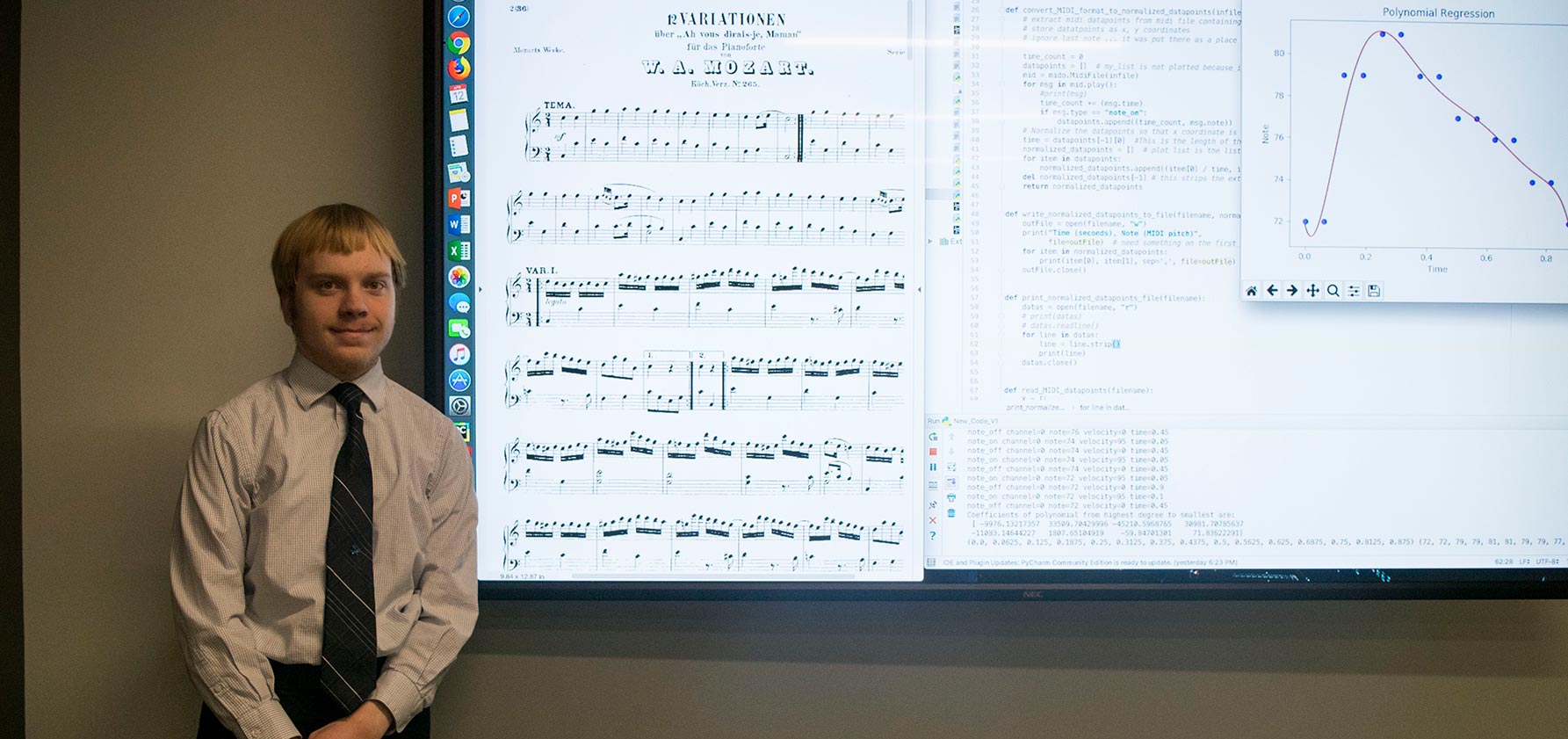
For Steven Berger ’20, music and mathematics, together, create balance. “I love the structure of mathematics,” he says. “When I am proving a mathematical theorem, I am going to find out if it’s true or false.” Music is the opposite. “I can express how I am feeling through music,” says Berger, “and I enjoying looking at the work of different composers and discovering how they express their feelings.”
Berger’s introduction to music came in fourth grade when he began taking cello lessons. In 7th grade, he picked up the piano, and when he arrived at Moravian, he chose to study organ and piano formally. While still proficient in the cello, Berger, the organist at his church, performs regularly on the piano and organ during Sunday worship services.
Math was a constant in Berger’s intellectual life, and before setting foot on Moravian’s campus, he knew he would choose it as his major. But he didn’t know he would blend his two passions until his first-year writing seminar with Nate Shank, associate professor of mathematics. “Dr. Shank asked us to write a paper about how math connects with a field outside of mathematics,” Berger explains. “I chose music, and ever since I’ve been researching that connection.”
Discovering the Mathematics of Music
A course in 20th-century music, taught by professor Larry Lipkis, piqued Berger’s interest in the mathematical foundations of the works of that time. “It’s an interesting period in music history because modernist composers experimented with abandoning the long-standing traditional boundaries of composition,” says Berger, who gives the example of Austrian-born Arnold Schoenberg (1874-1951) who broke traditional tonal rules of harmony to create a new kind of music. He developed a 12-tone row, an ordering of 12 different pitches, which formed the basis of his atonal compositions. “When you hear a piece of Schoenberg’s music—Piano Concerto, Op. 42, for example—the notes may sound random, but an analysis shows they are mathematically organized,” explains Berger.
American composer Harry Partch (1901-1974) pushed musical boundaries even farther, continues Berger, “He developed a 43-tone scale and then designed original instruments (such as the gourd tree) that could play those notes.” Here is Partch’s work “Windsong.”
Intrigued, Berger explored mathematical music on his own and presented his research, “Twentieth Century Experimental Music and its Mathematical Foundations,” at the 2019 Moravian College Student Mathematics Conference held on February 23. That work blossomed into an honors project under advisors Nate Shank, associate professor of mathematics, and Greg Schaper, associate professor of computer science.
Using Math to Discover Music
Berger wanted to analyze music mathematically to reveal the structure of musical compositions and to define the styles of different composers. So he developed a software program, using the Python programming language, that creates a precise mathematical representation of a given musical composition. The program, Mathematical Music Modeler (MMM), uses polynomials derived from MIDI (Musical Instrument Digital Interface) files to graph the phrases in each of the four lines of a piece of music: soprano, alto, tenor, and bass. Berger began by analyzing hymns, which are easily divided into phrases. For his honors project, he applied his program to the analysis of “Amazing Grace,” but he has analyzed other music as well, including some of the works of Johann Sebastian Bach (1685-1750). “Whereas many composers would focus on the soprano and bass lines and then fill in the alto and tenor parts with notes that make sense musically, Bach would often borrow the soprano line from other pieces of music and then create ingenious harmonies in the lower three lines,” says Berger. “The complexity of Bach is in the combination of the notes on all four lines, and the result is the incredible harmonies he creates.”
Berger didn’t build MMM merely to serve his own curiosity, it has practical applications. It could be used to determine copyright infringement by examining pieces of music that sound similar. As a means of defining the styles of different composers, it can be used to identify the composer or time period of a given piece whose composer is unknown. In addition, long works, like symphonies, become huge music files, but using polynomials, says Berger, we can compress them down into files that can be more easily stored.
What’s next in Berger’s music and math journey? “I want to continue to modify the software and develop it’s capabilities to analyze more complicated music as well as represent the mathematical structure of chord progressions,” he says.
Berger, who will graduate this May with a B.S. in mathematics and B.A. in music, is pursuing graduate school for mathematics with an eye to those select programs that combine math and music theory—his passion, his balance.